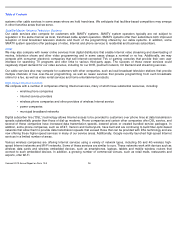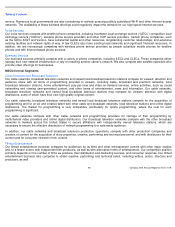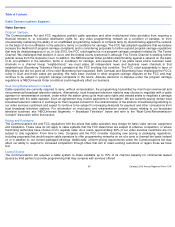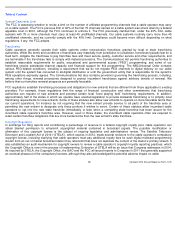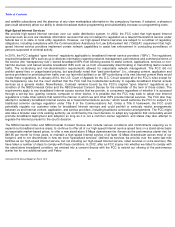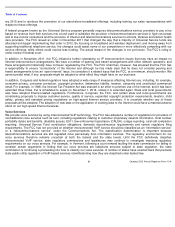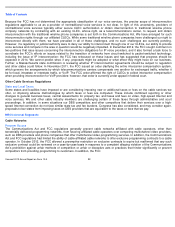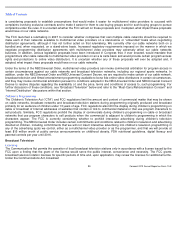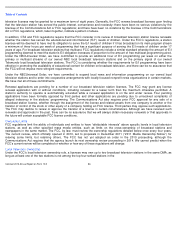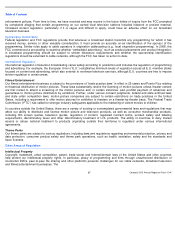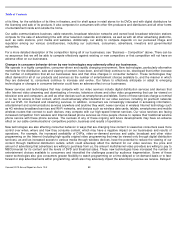Comcast 2013 Annual Report Download - page 29
Download and view the complete annual report
Please find page 29 of the 2013 Comcast annual report below. You can navigate through the pages in the report by either clicking on the pages listed below, or by using the keyword search tool below to find specific information within the annual report.
Table of Contents
television licenses may be granted for a maximum term of eight years. Generally, the FCC renews broadcast licenses upon finding
that the television station has served the public interest, convenience and necessity; there have been no serious violations by the
licensee of the Communications Act or FCC regulations; and there have been no violations by the licensee of the Communications
Act or FCC regulations, which, taken together, indicate a pattern of abuse.
In addition, CTA and FCC regulations require that the FCC consider in its review of broadcast television station license renewals
whether the station has served the educational and informational (
“E/I”) needs of children. Under the FCC’
s regulations, a station
licensee will be deemed to have met its obligation to serve the E/I needs of children if it has broadcast on its main program stream
a minimum of three hours per week of programming that has a significant purpose of serving the E/I needs of children under 17
years of age. For broadcast television stations that multicast, FCC regulations include a similar standard whereby the amount of E/I
programming deemed to meet the station’
s E/I obligation increases in proportion to the amount of free multicast programming aired.
Under the NBCUniversal Order, we have committed to provide an additional hour of E/I programming per week on either the
primary or multicast streams of our owned NBC local broadcast television stations and on the primary signal of our owned
Telemundo local broadcast television stations. The FCC is considering whether the requirements for E/I programming have been
effective in promoting the availability of educational content for children on broadcast television, and there can be no assurance that
the FCC will not impose more stringent requirements.
Under the NBCUniversal Order, we have committed to expand local news and information programming on our owned local
television stations and to enter into cooperative arrangements with locally focused nonprofit news organizations in certain markets.
We have met all of these commitments.
Renewal applications are pending for a number of our broadcast television station licenses. The FCC may grant any license
renewal application with or without conditions, including renewal for a lesser term than the maximum otherwise permitted. A
station’
s authority to operate is automatically extended while a renewal application is on file and under review. Four pending
applications have been formally opposed by third parties and other applications are pending due to unresolved complaints of
alleged indecency in the stations’
programming. The Communications Act also requires prior FCC approval for any sale of a
broadcast station license, whether through the assignment of the license and related assets from one company to another or the
transfer of control of the stock or other equity of a company holding an FCC license. Third parties may oppose such applications.
The FCC may decline to renew or approve the transfer of a license in certain circumstances. Although we have received such
renewals and approvals in the past, there can be no assurance that we will always obtain necessary renewals or that approvals in
the future will contain acceptable FCC license conditions.
Ownership Limits
FCC regulations limit the ability of individuals and entities to have “attributable interests”
above specific levels in local television
stations, as well as other specified mass media entities, such as limits on the cross-
ownership of broadcast stations and
newspapers in the same market. The FCC, by law, must review the ownership regulations detailed below once every four years.
The current review, which officially opened in 2010, led to proposals in December 2011 (“2011 Media Ownership Notice”)
for
relaxing some limits, but retaining others. The FCC has not yet adopted an order in the 2010 proceeding, although the
Communications Act requires that the agency launch its next ownership review proceeding in 2014. We cannot predict when the
FCC’s current review will be completed or whether or how any of these regulations will change.
Local Television Ownership
Under the FCC’
s local television ownership rule, a licensee may own up to two broadcast television stations in the same DMA, as
long as at least one of the two stations is not among the top four-ranked stations in the
Comcast 2013 Annual Report on Form 10
-
K
24


